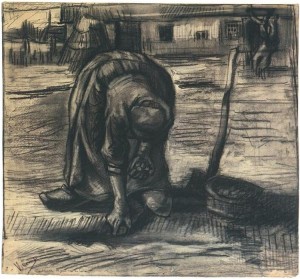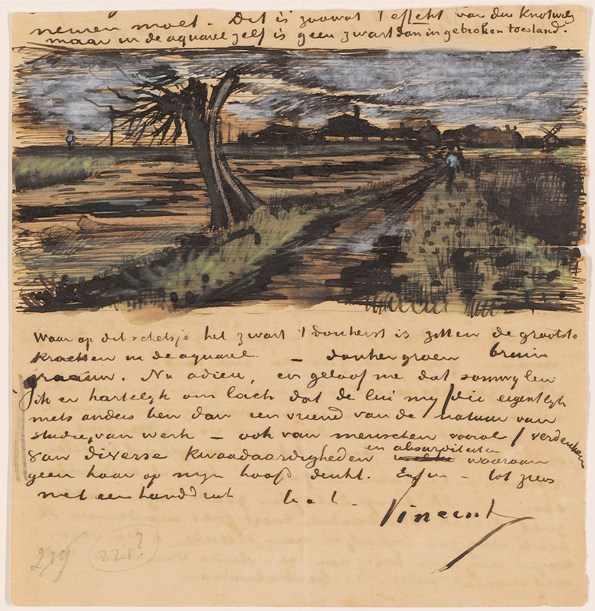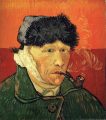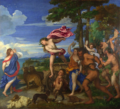The first Van Gogh exhibition in the UK for about 40 years, this one was a must-see. Not being an artist myself, I was interested to learn about the man I’d only touched on at school and knew only the bare facts about. Since I went, I’ve researched more about this Van Gogh bloke than I ever thought I’d want to! If you’ve been to this exhibition, please do add your comments and experiences of it. And although it ends soon, do consider going yourself if can get a free day!
The Real Van Gogh: The Artist And His Letters
The exhibition focuses mainly on the correspondence between Van Gogh and his art-dealer brother Theo (and to a lesser degree with his sister, Willemien). Sketches (referred to as Van Gogh as ‘scratchings’) – sometimes in ink, sometimes in colour – of proposed, half-finished and completed paintings adorn many of the letters, with footnotes by the artist about what he was hoping to achieve, how he felt about the work and the circumstances surrounding his creation of it.

The descriptions are as vivid in their words as they are in Van Gogh’s mind: “…here’s a croquis of the latest canvas I’m working on, another sower. Immense lemon yellow disc for the sun. Green-yellow sky with pink clouds. The field is violet, the sower and the tree Prussian Blue.” Each letter with a sketch is (usually) positioned adjacent to the finished work, which results in slow tennis match-like movements of the head by groups of people comparing the details of each. I like the way the letters are mounted and displayed like works of art in their own right. So did everyone else, it would seem, as actually getting close enough to the letters to be able to see the details of the drawing, his words and that famous signature is a minor accomplishment in itself. The letters and paintings start off with Van Gogh’s very early works, his grey pen-and-ink drawings of dark, damp Holland pathways and marshes, his descriptions of teaching himself from drawing manuals: ‘if one lacks that knowledge, one will never give birth to anything’, and trying to master perspective in his drawings.
I found the pen and ink and black chalk drawings of his earlier time spent in the Netherlands fascinating; his ‘Peasant in Action’ series was inspired after the criticism he received for his famous ‘The Potato Eaters’ in 1885. The series intended to improve his technique for figure drawing and he drew peasants in his local community (mention of paying them for posing is made in his letters). The drawings, many in chalk, make for a striking wall of images; one cannot help but notice not only the humility of the figures, but also the hard work they endured just to survive from the land – one one wall nearly every one is bent over double from the waist. However, the rigidity of the figures is also revealing of the troubles Van Gogh had in capturing fluid movement when drawing people, a point the exhibition examines in some depth. The landscapes are bleak and we are reminded how close the relationship between Van Gogh and the countryside he captured was; he used reed from the land to create his works and his respect for the peasants he captures in their aching work and the hard land they’re working on is glaringly obvious.

Not knowing much at all about Van Gogh apart from the famous works, the fact he cut off his ear, suffered from mental illness and commit suicide at an early age – the usual school-taught facts which now makes me feel rather ashamed that prior to this exhibition, I’d thought that was pretty much all I’d want to know about him – I discovered countless little gems of information which constantly reveal themselves from his letters. His accounts of his struggles to lift colour into his work instead of the darker tones he was maybe more naturally attracted to and which are heavily featured in his early works: ‘I have made a series of colour studies in painting, simply flowers….trying to render intense COLOUR and not a GREY harmony.” His additional struggles of capturing the human form…something that didn’t seem to come naturally at first to the self-taught artist: ‘what used to seem to me to be desperately impossible is now gradually becoming possible, thank God. I’ve drawn a peasant with a spade no fewer than five times…’. His throwaway comment to Theo about how his wonderfully, yellow-ly vibrant portrait of ‘L’Arlesienne: Madame Joseph-Michel Ginoux with her Books,’ had been ‘knocked off in one hour’ , literally making my jaw drop. One hour?? Through the letters we discover personal glimpses of his life; his financial state, his living arrangements, detailed weather reports, his innermost thoughts, what he’s reading and often heart-rending accounts on his struggles as an artist, how Impressionism influenced his style and, more surprisingly, Japanese art: ‘all my work is based to some extent on Japanese art’.
The last two rooms of the exhibition display some of his last landscapes; beautiful, familiar brush strokes, soaring colour, blowsy blooms and clouds and all of them a pure joy to behold. You suddenly find yourself in a swirl of golden, hot countryside. His landscapes are relaxing, serene and breathe life into the very scenes he was trying to capture. Van Gogh painted seventy landscapes in the last seventy days of his life and it’s still jarring to think of the turmoil he must have been in when placed against the stark contrast of the life and beauty in the paintings.

His final letter to Theo is heartbreaking; large brown blobs of (supposedly) blood dot the unfinished, unsigned draft which was found in his jacket pocket after he had shot himself in the field. In it, he sums up his experience of having created all the magnificent, beautiful, dark, vivid, colourful and stunning art we’ve just had the privilege to walk through: “I risk my life for my work and my reason has half-foundered in it.”
I left wanting to return immediately; partly because we were unfortunately evacuated after the exhibition plunged into blackness and sirens started going off following a power cut along the whole of Piccadilly. But also because I felt I hadn’t seen enough the first time around due to the logistics of the display. And this is where the exhibition stopped short of being a stunningly brilliant one; it’s way too cramped for it’s popularity and the sheer size of the exhibits. You’re dealing with letters (small) and canvases (big) and hundreds of people trying to view these tiny little letters. Only half the Royal Academy’s main floor is used for the exhibition and it shows; people stand four of five deep trying to see one letter – very frustrating if you don’t have hours and hours to spare. As the exhibition begins with his work displayed chronologically, it is rather confusing (and frustrating) when chronological order stops and is replaced with themed ‘chapters’ such as Portraits, Colour and Japanese Prints, in which the dates of the works are a little all over the place. This achieved nothing but resulting in my losing my focus and I was not alone in this; I overheard more than a handful of quizzical objections. It’s true that the paintings selected to illustrate each theme (such as Colour) prove their point; my brother’s genuine-but-immensly-enthusiastic reaction to the vivid bold colours of ‘Basket Of Oranges’ was so extreme that I fleetingly considered hanging him on the wall next to it, his exultations drew so much attention. But I missed watching the visual development of Van Gogh’s techniques and his growth as an artist which we’d seen earlier. However, each new letter and painting or drawing is so breathtaking, not only for the content but for the sheer fact it is actually HIS life unfolding before you, that it does tend to override the initial confusion and mild irritation at having lost one’s thread.
But those imperfections have not stopped thousands of people flocking to see this really rather brilliant exhibition. Go. Take your time. Take the day off work. Visit the toilet BEFORE you go in. Wear comfy shoes. Don’t rush. And be prepared to get totally mesmerised, just as I was.
Running until April 18th 2010
http://www.royalacademy.org.uk/exhibitions/vangogh/
Gallery: Royal Academy Of Arts, London
The Gallery: Biiiiiiig! One of those buildings that has it’s shoulders puffed up as soon as you get anywhere near it, as if to remind you of the importance of the work you are about to see. You’ll need a map to get around it if you’re visiting more than the main exhibition.
History: Founded by George III in 1768, the Royal Academy is an independent, privately-funded institution, the ethos of which is to promote, educate and encourage debate of the arts through it’s exhibitions, talks and workshops.
Take:
* An umbrella if it’s raining; the queues for those buying tickets on the door for the bigger shows can be very long and the open courtyard doesn’t offer much protection from the elements!
* Comfortable shoes – as I said, it’s biiiiiiig!
* Glasses if you need them; depending on the popularity of the exhibition, you may well find yourself struggling to get close enough to study the text or finer details of some of the exhibits.
Don’t take:
* Pushchairs. That may not make me popular, but I saw more than two mothers really struggling around with the crowds and the stairs. I didn’t notice any lifts, although the website stresses that they exist. However, the advice to wheelchair users; ‘please contact a security guard if lift access is required’, suggests that they are not readily available?
* More than one shoulder-bag. We were lucky; we were at the front of the queue for the free cloakroom (bonus points for it being free!). However, the cloakroom is small and as the day went on we noticed lots of people lugging cumbersome bags around.
We liked:
* The architecture; it’s big, it’s imposing, but dammit it looks good!
* The main exhibition. So good I saw it twice.
* Plenty of seats around to rest your weary feet (amazing how tired one gets from shuffling slowly from amazing painting to amazing painting).
* Helpful staff who evacuated the entire exhibition safely after a blackout and sirens going off (this was during the first visit) without panic and reasonably fast after an initial minute of confusion. Also, absolutely no problems in re-using our tickets without question again later that month.
We furrowed our brows at:
* No lift access? If it was there (and apparently it is), it really wasn’t clear.
* The inability to get anywhere quite a proportion of the letters by Van Gogh; yes it was busy, but surely major exhibition galleries should be able to devise a method of exhibiting smaller pieces without it being necessary to stand on a stranger’s shoulders/get elbowed out of the way?
* The cold! It was cold! I’m not sure if this was for preserving the art but it doesn’t half get distracting after a bit.
Royal Academy of Arts
Burlington House
Piccadilly
London W1J 0BD
General enquiries: 020 7300 8000
Tickets: 0844 209 1919







